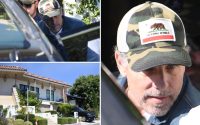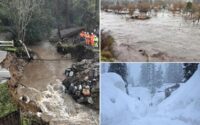American sniper Chuck Mawhinney holds record for deadliest aim
In Vietnam’s An Hoa Basin on Valentine’s Day, 1969, US Marine sniper Chuck Mawhinney lay under a canvas tarp in the dead of a humid night. Through his night-vision scope he watched a single North Vietnamese fighter wade through a chest-high river to scout for American activity on the other side.
The NVA soldier ended up just feet away from Mawhinney, who remained motionless with his sniper rifle trained between the man’s eyes.
When the scout decided all was clear, he crossed back over the river.
Shortly thereafter, Mawhinney’s real target appeared, a line of NVA soldiers American forces expected would attack that night.
The NVA entered the river in single file, crossing the water with their rifles held high in the air.

As their leader neared landfall, Chuck squeezed off a single shot. Blood, appearing greenish through Mawhinney’s starlight scope, blew from the back of the man’s head.
The remaining NVA quietly dropped low in the river, just their helmeted heads above water.
In what would become known as the “Valentine’s Day massacre,” Chuck Mawhinney blasted them like tin cans on a fence, “dispatching” 16 NVA soldiers in less than a minute.

“Pith helmets and bodies floated down the river,” writes Jim Lindsay in “The Sniper: The Untold Story of the Marine Corps’ Greatest Marksman of All Time” (St. Martin’s Press).
Born in 1949 and growing up in small-town Oregon, Chuck Mawhinney was always a shooter.
At 4 he “borrowed” his grandfather’s shotgun and — with both barrels — blasted a flock of quail full of birdshot.
His collarbone may have broken, but Mawhinney had provided dinner for the next couple of days. At 12 he used his brand-new Daisy Red Rider BB gun to shoot through the eyes the blackbirds stealing fruit from his grandfather’s cherry trees.
In his teens, he used his new pilot’s license and his father’s plane to hunt from the sky, killing rabbits and deer from on high.
In high school, Mawhinney loved stock-car racing, girls and beer, but he frequently got himself into trouble with the law (mostly for underage drinking).
Mawhinney thought a military career was a good option, but when drafted in 1967 he realized his checkered legal past might be a roadblock.
With the help of a hometown constabulary who made the records disappear, Mawhinney became a US Marine.

He planned to be an aviator, but slept through an important test because he was hungover.
While glumly working kitchen duty in punishment, Mawhinney learned of a new Marine sniper program.
His fate was sealed, and soon he was in Vietnam.
His in-country career didn’t start as planned, being screamed at as an FNG (“F–king New Guy”) that the “Corps doesn’t need snipers. It needs grunts!” Mawhinney slogged through his initial time in Vietnam as an infantryman, involved in gunfights but never knowing if his shots hit their marks.
That would change after he was transferred to a scout sniper platoon, assigned to work as spotter for an experienced shooter wrapping up his tour.
Chuck picked the man’s brain to learn from his experiences, but when his sniper one day couldn’t see the human target, his mentor told him to act.
“You shoot the son of a bitch!”
Mawhinney did. It was his first confirmed kill. He had always believed the biblical commandment “Thou shalt not kill,” but kneeling over the dead Viet Cong officer he’d shot between the eyes from 300 yards away, he felt no remorse for dispatching an enemy aiming to kill his American comrades-in-arms.
“Thou shalt not kill my fellow Marines,” Chuck whispered to the corpse.

For three tours of duty, Mawhinney protected the Marine platoons around him.
At times those platoons returned the favor. Once Chuck and his spotter were on their own, trapped in a bomb crater, surrounded completely by NVA soldiers firing AK-47s. Mawhinney foresaw no way they would survive, at least until hearing a symphony of marine battle cries and American M-16s.
“It was sweeter than music,” Lindsay writes.

That wasn’t Mawhinney’s only scare in Vietnam.
There were massive rats and enormous cockroaches, deadly snakes of every poisonous variety and scorpions whose stings could be fatal.
He had to pick shrapnel out of his chest from an exploding booby trap that killed a nearby Marine.
He lived through being shot in the side, mostly because the VC bullets hit a can of peaches in his backpack.
One night Mawhinney engaged in hand-to-hand combat with an assailant who jumped into his muddy foxhole, the intruder powerfully pushing Mawhinney into the crumbling walls and stabbing him repeatedly.
Mawhinney managed to kill the enemy in the dark with his .45 pistol, with his flashlight later illuminating what was actually a Vietnamese pot-bellied pig.

And as a sniper, Mawhinney was vengeance itself in those Southeast Asian jungles.
He averaged four kills per week of combat duty in Vietnam, ultimately accumulating a body count of 103 dead, a record unmatched in the annals of Marine history.
He never relished killing, stressing that he was only “doing his job” in Vietnam.
But if he was raised to believe “Thou shalt not kill,” the mantra “Thou shalt not kill my fellow Marines” was the one he really lived.


